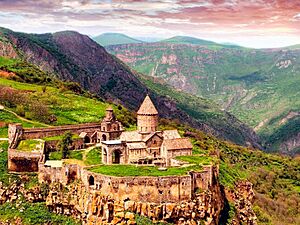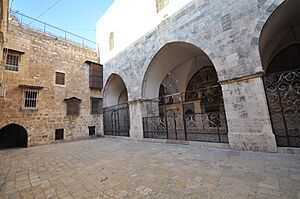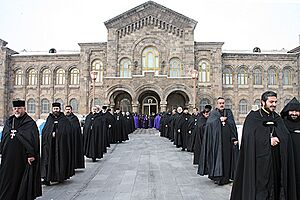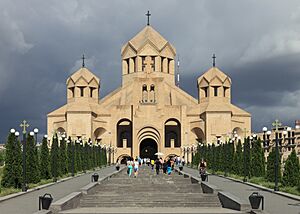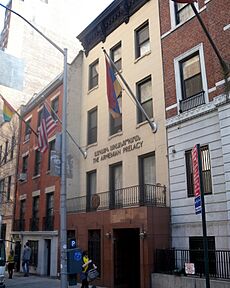Armenian Apostolic Church facts for kids
Quick facts for kids  Armenian Apostolic Church |
|
|---|---|
| Հայ Առաքելական Եկեղեցի (Armenian) | |
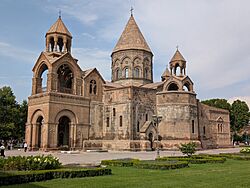
Etchmiadzin Cathedral, the mother church of the Armenian Apostolic Church
|
|
| Type | Autocephaly |
| Classification | Christian |
| Orientation | Oriental Orthodox |
| Scripture | Septuagint, New Testament, Armenian versions |
| Theology | Oriental Orthodox Theology |
| Polity | Episcopal |
| Catholicos of All Armenians | Karekin II |
| Associations | World Council of Churches |
| Region | Armenia, Armenian diaspora |
| Language | Classical Armenian |
| Liturgy | Armenian Rite |
| Headquarters | Mother See of Holy Etchmiadzin |
| Founder | Gregory the Illuminator Bartholomew the Apostle Thaddeus (Jude) |
| Origin | c. 1st century Kingdom of Armenia |
| Independence | 610 at the Third Council of Dvin |
| Separated from | Patriarchate of Constantinople in the Second Council of Dvin (554) |
| Separations | Armenian Catholic Church |
| Members | 9 million (self-reported) |
| Other name(s) | Armenian Church |
| Logo | 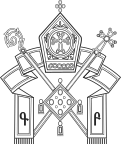 |
|
|
The Armenian Apostolic Church (Armenian: Հայ Առաքելական Եկեղեցի, romanized: Hay Aṙaqelakan Ékełetsi) is the national church of Armenia. It is a very old Christian church. It is part of the Oriental Orthodox group of churches. The Armenian Apostolic Church uses its own special way of worship called the Armenian Rite.
Armenia was the first country in history to make Christianity its official religion. This happened in the early 300s AD. It was during the time of King Tiridates III.
Church traditions say the church started with two of Jesus's apostles. These were Bartholomew and Thaddeus (Jude). This was in the 1st century. Later, Gregory the Illuminator became the first official leader of the church. Sometimes, people call it the Armenian Church or Armenian Gregorian Church.
It is important not to confuse the Armenian Apostolic Church with the Armenian Catholic Church. The Armenian Catholic Church is a different church. It is connected to the Pope in Rome.
Contents
History of the Armenian Church
How the Church Began
The Armenian Apostolic Church believes its leaders are connected directly to the apostles. This is called apostolic succession. It means their leaders follow a line back to Bartholomew and Thaddeus (Jude).
Tradition says Thaddeus healed a king named Abgar V around AD 30. This led the king to become Christian. Thaddeus then traveled through Armenia. He converted the daughter of King Sanatruk. Both she and Thaddeus were later killed. Bartholomew also came to Armenia. He brought a picture of the Virgin Mary. He started a nunnery where a temple used to be. Bartholomew also converted King Sanatruk's sister. She and Bartholomew were also killed.
Historians like Eusebius and Tertullian wrote about early Armenian Christians. They faced hard times from kings like Axidares and Khosrov I. Then, King Tiridates III became Christian. He was converted by Gregory the Illuminator.
Ancient Armenia was the first country to make Christianity its official religion. This happened between 300 and 301 AD. This was a very important step for Armenia. It helped Armenia become different from its neighbors.
King Tiridates III made Gregory the first Catholicos of the Armenian Apostolic Church. A Catholicos is like a main bishop. Gregory then built churches and monasteries. He also trained many priests and bishops.
Gregory had a special vision in the old capital city of Vagharshapat. He saw Christ coming down and striking the earth. A great church with a huge cross appeared from that spot. Gregory believed God wanted him to build the main Armenian church there. With the king's help, he built it. They renamed the city Etchmiadzin. This means "the place where the Only-Begotten descended."
Armenian Christian Identity Grows
Christianity became stronger in Armenia in the 400s. This was because the Bible was translated into the Armenian language. A smart monk named Saint Mesrop Mashtots did this. Before the 400s, Armenians spoke their language but had no alphabet. So, the Bible and church services were in Greek or Syriac.
Around 405 AD, Mesrop created the Armenian alphabet. After that, the Bible and church services were translated into Armenian. This led to a great time for Armenian writing and culture.
The Armenian Church had some disagreements with other Christian churches. This happened after the Council of Chalcedon in 451 AD. The Armenian Church did not accept all the decisions made there.
In 609–610 AD, the Third Council of Dvin was held. This meeting was to discuss differences with the Georgian Church. The Georgian Church had accepted the decisions of Chalcedon. After this meeting, the Armenian Church and Georgian Church became separate.
Attempts to Reunite with Other Churches
Over the years, there were attempts to reunite the Armenian Church with other Christian churches. In 862 AD, the Armenian Apostolic Church met with the Syriac Orthodox Church of Antioch and the Eastern Orthodox Church. They wanted to find Christian unity. Later, in the 1100s, the Armenians held the Council of Hromkla. This was another try to reunite with the Eastern Orthodox Church.
In the 1400s, the Armenian Church took part in the Council of Basel-Ferrara-Florence. This was an effort to bring together the Roman Catholics, Eastern Orthodox, and Oriental Orthodox Churches. However, none of these meetings led to a lasting reunion.
Challenges and Persecution
In 1903, the Russian government tried to take property from the Armenian Church. But by 1905, the property was given back.
During the First World War, the Armenian Church faced hard times from the Ottoman Empire. The Armenian genocide happened during this war. Many church leaders and regular people were killed. This was an effort to remove Armenians from the region. Because of this, many Armenians moved to other countries. This spread Armenian Apostolic Christianity around the world.
On April 23, 2015, the Armenian Apostolic Church honored all the victims of the Armenian genocide. They were made saints. This was the largest event of its kind in history. About 1.5 million victims are often mentioned. This was the first time the Armenian Apostolic Church had made new saints in 400 years.
Beliefs of the Armenian Church
Understanding Miaphysitism
Like other Oriental Orthodox churches, the Armenian Church has been called "monophysite" by some. This is because it did not accept the decisions of the Council of Chalcedon. That council disagreed with the idea of one nature of Christ. The Armenian Church officially separated from Rome and Constantinople in 610 AD. This happened at the Third Council of Dvin.
However, the Armenian Apostolic Church says that calling them "monophysite" is not correct. They believe the teaching of Eutyches, which was called heresy at Chalcedon, is wrong. The Armenian Church follows the teaching of Cyril of Alexandria. He is also seen as a saint by other churches. Cyril described Christ as having one united nature. Both divine and human natures are together. This belief is called miaphysitism. The word "mono-" means "single" or "only." But "mia" simply means "one." This allows for a combined nature.
The Armenian and Roman churches have agreed on a common understanding of Christ. Other Oriental Orthodox churches, like the Coptic and Syriac Orthodox churches, have done this too.
Women in Church Roles
The Armenian Church does not allow women to become priests. However, women who live in convents have historically been ordained as deacons. When they become deacons, both men and women use the same ceremony. They both can chant the Gospel and help in the church service.
Monastic women deacons usually do not serve in regular churches. But one, Sister Hripseme, did serve in public services. This included services in the United States. The last monastic deaconess was Sister Hripsime Sasounian, who passed away in 2007. On September 25, 2017, Ani-Kristi Manvelian became the first parish deaconess in many centuries. She was 24 years old and was ordained in Tehran.
Women also help in other ways. They can be altar girls or lay readers. This is especially true in small churches where there are not enough boys or men. Women often sing in the choir or play the organ. They serve on church councils and volunteer for church events. They also help with fundraising and Sunday schools. Women's Guilds are groups of women who support the church. Wives of married priests, called Yeretzgin, also play an active role in the church.
Church Structure and Leaders
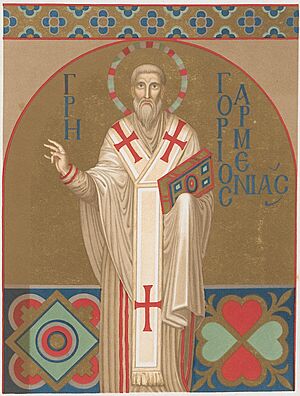
The Armenian Apostolic Church has two main leaders called Catholicoses. One is the Catholicos of All Armenians. He lives in Etchmiadzin, Armenia. This is the Mother See of Holy Etchmiadzin. The other is the Catholicosate of the Great House of Cilicia. Its main office has been in Antelias, Lebanon, since 1930.
Remember, the Armenian Catholic Church is separate. It has its own Patriarch-Catholicos. It is also connected to the Holy See of Rome.
Two Patriarchates
The Armenian Apostolic Church also has two important patriarchates. Both are under the Catholicos of All Armenians:
The Armenian Patriarchate of Jerusalem. Its home is in the Armenian Quarter of Jerusalem. Archbishop Nourhan Manougian has led it since 2013.
- The Armenian Patriarchate of Constantinople. This one is in Istanbul, Turkey. It covers the modern-day Republic of Turkey. Archbishop Sahak II Mashalian has led it since 2019.
Church Areas Around the World
The Armenian Apostolic Church has many areas, called eparchies or dioceses. These are spread across Armenia and other countries.
In Armenia
- Aragatsotn eparchy
- Diocese of Armavir
- Ararat Patriarchal eparchy
- Artik eparchy
- Gegharkunik eparchy
- Gougark eparchy
- Kotayk eparchy
- Shirak eparchy
- Syunik eparchy
- Tavush eparchy
- Vayots Dzor eparchy
- Artsakh eparchy
In Other Countries (Diaspora)
- Europe
- Diocese of Russia and New Nakhichevan
- Diocese of Southern Russia
- Diocese of Ukraine
- Exarchate of Central Europe
- Exarchate of Western Europe
- Diocese of Georgia
- Diocese of Romania
- Diocese of Bulgaria
- Diocese of Greece
- Diocese of Germany
- Diocese of Switzerland
- Diocese of France
- Diocese of Great Britain and Ireland
- Middle East
- Diocese of Egypt
- New World
- Diocese of Canada
- Western Diocese (USA)
- Eastern Diocese (USA)
- Diocese of Australia and New Zealand
- Diocese of Argentina
- Diocese of Uruguay

Areas Under the Catholicos of Cilicia
These are the current areas under the Catholicosate of Cilicia:
- Armenian Prelacy of Lebanon, in Beirut
- Armenian Prelacy of Aleppo, in Aleppo
- Armenian Prelacy of Jezireh, in Qamishli
- Armenian Prelacy of Isfahan, in New Julfa
- Armenian Prelacy of Atrpatakan, in Tabriz
- Armenian Prelacy of Tehran, in Tehran (Saint Sarkis Cathedral)
- Armenian Prelacy of Kuwait & Neighboring Countries, in Kuwait City
- Armenian Prelacy of the United Arab Emirates and Qatar, in Abu Dhabi
- Armenian Prelacy of Cyprus, in Nicosia
- Armenian Prelacy of Greece, in Athens
- Armenian Prelacy of Canada, in Montreal
- Armenian Prelacy of the Eastern United States, in Manhattan, New York
- Armenian Prelacy of the Western United States, in Sunland-Tujunga, Los Angeles
- Armenian Prelacy of Venezuela, in Caracas
Military Chaplains
The Armenian Church has a program for military chaplains. These are clergymen who serve as spiritual guides for the Armed Forces of Armenia. They organize religious programs, give talks, and lead prayers for soldiers.
The Church's Role in Armenia and Beyond
In Armenia
The role of the Armenian Apostolic Church in Armenia is written in the country's constitution. It says the church has a special historical mission. It helps with the spiritual life, culture, and identity of the Armenian people.
Some people have questioned if this part of the constitution is fair to other religions. In 2009, there were ideas for new laws. These laws would make it a crime for other religious groups to try to convert members of the Armenian Apostolic Church. They would also stop minority groups from spreading "distrust" in other faiths.
Many people see the Armenian Apostolic Church as protecting Armenian national identity. It is seen as a key part of Armenian history. A survey in 2018 showed that 82% of people in Armenia think it's important to be Christian to be truly Armenian. In 2024, 79% of people in Armenia said they belong to the Armenian Apostolic Church.
A 2015 survey showed that 79% of people in Armenia trust the church. Only 8% said they distrust it. The church was a center for Armenian freedom activities. This was especially true when Armenia was under Persian and Ottoman rule.
In Artsakh
After the Soviet Union took over Armenia, many religious places in Artsakh were closed. Church leaders were often sent away or killed.
Later, the Armenian Apostolic Church started its activities again. Weddings, baptisms, and Sunday services became common. Since 1989, the church has rebuilt or built over 30 churches worldwide. In 2009, the government of Artsakh passed a law. It said that only the Armenian Apostolic Church could preach in Artsakh. However, other religious groups could get permission to worship there. After the fall of Artsakh, most of its people moved back to Armenia or to other countries.
Armenian Communities Around the World
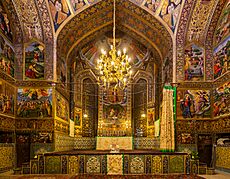
Outside of West Asia, there are many Armenian Apostolic churches. In 2024, the church had about 600,000 members in North America. It had 10,000 members in South America. There were also 25,000 members in Europe.
The Armenian Patriarchate of Constantinople in Turkey and the Armenian Apostolic Church of Iran became important communities. These churches grew to be the largest Christian groups in mostly Muslim countries.
In the United Kingdom, the Armenian community has grown. In 2024, there were three main Armenian churches. These were St Sarkis and Saint Yeghiche in London. There was also Holy Trinity in Manchester.
Ethiopia has had an Armenian church since the 1920s. This was when groups of Armenians moved there after the Armenian genocide.
See also
 In Spanish: Iglesia apostólica armenia para niños
In Spanish: Iglesia apostólica armenia para niños
- Religion in Armenia
- Armenian Catholic Church
- Armenian church architecture
- Armenian Patriarchate of Constantinople
- Armenian Patriarchate of Jerusalem
- Holy See of Cilicia
- Saint Narek chapel
Lists
- List of Catholicoi of Armenia
- List of Armenian Catholicoi of Cilicia
- List of Armenian Patriarchs of Constantinople
- List of Armenian Patriarchs of Jerusalem


